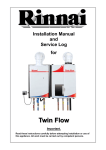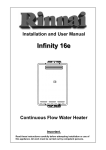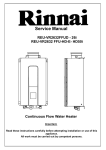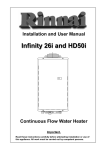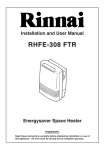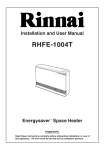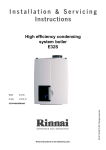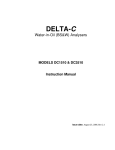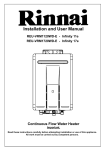Download Rinnai RHFE-1510F Specifications
Transcript
5 has 11 12 15 MAINTENANCE 17.4 , 13.6 27 28 TROUBLESHOOTNG THE HEATER 29 30 31 T Warranty Installation Instructions As the purchaser of this high quality Rinnai Space Heater you are provided with the following conditional warranty. Heat Exchanger: All other Parts: Labour: 5 years* 1 year 1 year *Full Heat Exchanger replacement (parts only) in the first five years, thereafter reducing as follows, subject to conformity. A replacement heat exchanger will be supplied at the normal selling price less the following discounts. Year 6: 80% discount Year 7: 60% discount Year 8: 40% discount Year 9: 20% discount Year 10: 10% discount IMPORTANT INFORMATION 1. Gas safety (Installation & Use) regulations 1998 are the ‘Rules in force’. In your own must be used interest and that of safety, it is law that all gas appliances are installed by competent persons in accordance with the above regulations. Failure to install appliances correctly could lead to prosecution. Other persons should NOT attempt to install this equipment. 2. Unpack the appliance and check it carefully. If it appears to have any defects or damage DO NOT INSTALL, contact your supplier. 3. The heater is intended to be used to raise the temperature in a room or office, etc. Do not use it for any other purpose without consulting Rinnai UK. 4. This appliance is safe if correctly installed and sited. Please comply carefully with these instructions. e This warranty does not cover cleaning and normal wear and tear, calls of this nature may be chargeable. Please check the troubleshooting chart on page 29 before asking for a service call. You may be able to overcome the problem, or e the heater may be operating normally. Service calls to a heater that is operating normally may be chargeable, even if the heater is under warranty. The installer is responsible for the heater's correct installation. CONDITIONS 1. It is a condition of this warranty that the heater shall have been serviced annually during its lifetime by a suitably qualified engineer, and that it must have been installed and used in accordance with these instructions. 2. Failing to use genuine Rinnai spare parts, or attempting to repair the appliance yourself may invalidate the warranty. 3. The serial number of the heater must be supplied prior to any claim being processed. 3 5. This appliance is to be used with Natural Gas (G20) or Propane (G31) only. The data plate on the side of the unit will show which gas it is set up for. 6. Installation must be carried out in accordance with the current issue of the following: •Building regulations issued by the Department of the Environment and Building Standards (Scotland) Regulations. •I.E.E. Wiring regulations for electrical installations. •Gas safety (Installation and Use) Regulations current issue. •BS 5871 part 1:2001 •BS 5440 part 1 and 2 •BS 6891 •BS 5482 •Local byelaws •Health and safety at work etc. Act 1974 •Children and Young persons act 1933, revised 1952 •Such other specifications and regulations that may supersede or complement the above documents. 4 not no not to 5 6 Flue Terminal Position Minimum Distances Dimension 7 Terminal Position Distance A Directly below an opening, air brick, opening windows, etc. 300mm B Above an opening, air brick , opening window, etc. 300mm C Horizontally to an opening, air brick , opening window, etc. 300mm D Below gutters, soil pipes or drain pipes. 75mm E Below eaves. 200mm F Below balconies or car port roof. 200mm G From a vertical drain pipe or soil pipe. 150mm H From an internal or external corner. 200mm I Above ground, roof or balcony level. 300mm J From a surface facing the terminal. 600mm K From a terminal facing a terminal 1200mm L From an opening in a car port. ( e.g. door, window) into a dwelling 1200mm M Vertically from a terminal on the same wall. 1500mm N Horizontally from a terminal on the same wall. 300mm O From the wall on which the terminal is mounted N/A P From a vertical structure on the roof. N/A Q Above an intersection with roof. N/A 8 gas type and pressure are compatible with the appliance. the instructions Diagram on the right shows minimum clearances and distances from obstructions. Flue fittings must be positioned away from flammable materials and obstructions that effect surrounding airflow. Install flue fittings at an angle of 2 degrees from the surface. 600mm 300mm Flue is not designed to be positioned under floor, or below the level of the heater. Flue terminal must be kept clear of obstructions and plants because the combustion gases and vapour come out from flue terminal. Flue terminal must be kept clear of bags or empty cans so it does not get blocked. 9 10 Swing Louvre in point. Alternatively, remove plug and wire into a double-pole switched, 3A fused, spur. Warm air Open the gas valve fully. Flue Terminal Air s Dirty damage 11 . 12 Locking the control panel will prevent people tampering with the adjustments. If lock lamp is on, the control buttons will not alter the operation of the heater. (For Safety, if you push the stop button during operation, the heater will stop.) To alter the heater, you must cancel the lock function. e re re When glow the Lock function is set. re re l re ure re ure re always While the temperature is altered the set temp lamp will be lit and the set point will be displayed. After 5 seconds the current temp lamp will light and the current temperature will be displayed. 13 14 Connection Manifold 15 Sleeve Plate Terminal Body 16 - 400 must be used e e 17 18 Connect flexible hose to heater and tighten band with screw driver. Connect air inlet hose to the flue manifold. Tighten band with screw driver to secure hose i Exhaust Connect the extendable flue tube to the exhaust port of the flue manifold. Adjust the length of the extendable tube to meet exactly with the flue hole height. Pipe must not be extended beyond the Red line. below Fixing Find the location of each hole then fix the heater firmly with the screws provided. Rear Side s Attach the left and right side rear covers provided with the heater. 19 20 Example of flue tube extension stop end Connection Manifold Terminal Body stop end Concentric Port Sleeve plate Flue Tube of Unit Flue Tube of Unit Flue Tube of Unit stop end Put grease on connecting O-rings. Use the same air inlet hose length as the length of the flue manifold. 21 22 Separate the Terminal into 3 parts; sleeve plate, connection manifold, and the terminal body. This is done by pulling the outside terminal from the connection manifold, then pull sleeve off outer terminal. Spread springs out so they are slightly bigger than the hole. Extension tube (optional extra) is needed for any extension. Maximum extension is 5m in length This allows for a maximum of bends Maximum 3 bends Maximum 5m length ing Push the terminal body through from outside. -Install the terminal body tilting at a slight angle to the surface and stick it firmly to the wall. -Put silicon between the wall and the flue terminal so there is no gap after fixing the flue terminal. ing Insert the sleeve plate over the spring loaded ties of the terminal body. Be careful not to damage the O-ring on the body. Pull the ties tight so the sleeve plate sticks to the wall then fix the ties on sleeve plate lugs. They will extend 2-3 slots past start point. ties the tie. - Flange is marked This way up with an arrow stick through or the word Top, and must be installed this way. - Secure the sleeve to the wall using the 4 holes of the flange. - After sleeve is secure, cut off the rest of the tie. (The parts that stick through to the inside.) - Insert connection manifold into Sleeve. Secure with the 3 screws provided. The manifold can be turned to any angle. Condensed water can form in the tube when extended. Make sure there are no low spots. Do not run If condensed water comes in to the heater, the water tray can overflow. Do not run flue more than 2m vertically. Low Spot s of flue tube must be same. 23 24 Testing the Unit Wiring Diagram Purge air and sw arf f rom gas line. Connect gas (1/2 inch BSP). Connection can be easily reached from the top rear of the unit. x Check for escapes, using soapy water after turning gas on. x Remove fan filters. x Remove front covers, 2 screws at the bottom of lower cover, 2 at bottom of upper cover. x Remove inner right hand cover (5 screws). x Remove test point screw, attach pressure gauge to test point, (on solenoid valve). Turn power on. (CAUTION: 240V inside unit). x Turn thermostat to ‘HI’, turn control to ‘ON’. Unit should ignite within 10 seconds. (If unit does not ignite first time it will spark again after 10 seconds). x If unit does not ignite, there may be air in the gas line. Turn control ‘OFF’ then ‘ON’ again. x Check pressure compared to value on page 30, regulator is factory set, and should be correct. x If pressure is incorrect, check supply before altering regulator. x Turn control to ‘OFF’ position, remove pressure gauge and replace test point screw. x Re-light unit, on ‘HI’ setting. Slide thermostat control slowly towards the ‘LO’ position, the heater will modulate down, then cut out. (Depending on the room temperature). x Turn the power off. x Replace the casing. x Turn power on. x Recheck operation. x 25 265 Dip Switch Settings Central Timer Control off on off Overheat Switch CI Room Temp Sensor Faulty on Blocked Flue Terminal Blocked Air Filter Power Failure Warm Air Obstruction Gas Type Gas Pressure Convection Fan coil resistance PCB voltage to Convection Fan PCB voltage to Overheat Circuit Thermal Fuse Resistance Overheat Switch Resistance Room Temp Thermistor Resistance Overheat Temp Overheat Thermistor Resistance Sensor Faulty H6 Overheat Thermal Fuse dI Sparker Failure PCB Sparker input voltage Spark Gap Flame Rod carboned up No Ignition PCB bI & ComBlocked burner ports bustion Lamp Blocked Flue Terminal Gas Type Combustion Fan Gas Pressure EO Communication PCB Error (Ghost Flame Sensor Flame) Sparker Physical Blockages Flame Failure b3 + Combustion Lamp Flame Rod Blocked Flue n2 Air Proving Device Faulty PCB Combustion Fan Kinked/disconnected air tube Heat Exchanger Blocked Air Proving Senser Check On/Off switch n1 On/Off Button sub PCB Faulty PCB C2 Computer Programming Computer Programming Central Control System Emergency Cut Off If controlled by a central timer, dip switch 3 must be in the ON position. To use a time clock you will also require a transformer and sub PCB available from Rinnai. When a time clock is used the appliance On/Off button will not operate. If Emergency cutoff loses signal unit will stop. Emergency Cut Off can not be used with Central Control System. 27 HI Stand Alone Control 1 2 3 4 1 2 3 4 Fault Codes 28 MAINTENANCE doe attempt a gh Repeat the from occurs dust this Rinnai UK. Do not attempt to disassemble or repair the product unless trained to do so. 29 30 T ROUBLESHOOTING THE HEATER Refer to the list below. Rinnai UK. 17.4 o re re 1/2 in BSP a re t ed re plate. 31 32 Notes Our service personnel are fully trained and equipped to give you the best service on your Rinnai appliance. If you require service please ring the contact number on this page. 9 Christleton Court Manor Park Runcorn WA7 1ST 01928 531 870 01928 531 880 www.rinnaiuk.com 33 RHFE-1510F CUSTOMER OPERATING AND INSTALLATION INSTRUCTIONS Read the user's instructions before lighting the appliance. This appliance shall be installed in accordance with these Manufacturers Installation Instructions, Local Gas Fitting Regulations, any other relevant Statutory Regulation, and must be installed, serviced and removed by an authorised Person.


















